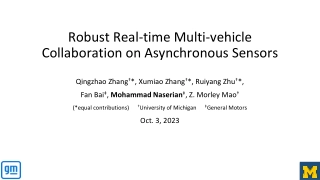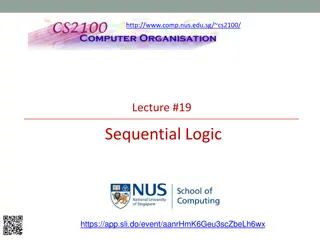Robust Real-time Multi-vehicle Collaboration on Asynchronous Sensors
A robust and real-time multi-vehicle collaboration system for asynchronous sensor data, addressing the synchronization problem and inaccurate blind spot estimation. The system leverages prediction algorithms for synchronization and enables on-demand data sharing for accurate blind spot estimation.
11 views • 12 slides
AI Applications in Dermatology - Advancements and Impacts
AI is revolutionizing dermatology through automated diagnosis, disease classification, treatment planning, and tele-dermatology. Initiatives like SkinVision and Miiskin PRO are utilizing AI to empower individuals in self-assessing skin spots and detecting skin cancer early. Interim updates include w
0 views • 7 slides
Understanding Petri Nets: A Versatile Tool for Modeling Systems
Petri nets are a powerful modeling tool characterized by their asynchronous state transitions, making them ideal for representing concurrent and distributed systems. Originating from Carl Adam Petri's work in the 1960s, Petri nets have found diverse applications in fields such as computer science an
1 views • 84 slides
Enhancing Learning with Swivl Recording Technology
Explore the innovative Swivl recording technology designed for asynchronous learning and professional development purposes. The Swivl Robot, along with Reflectivity software, provides secure video recording capabilities with options for live streaming and self-reflection. Learn how this technology c
1 views • 16 slides
Apache MINA: High-performance Network Applications Framework
Apache MINA is a robust framework for building high-performance network applications. With features like non-blocking I/O, event-driven architecture, and enhanced scalability, MINA provides a reliable platform for developing multipurpose infrastructure and networked applications. Its strengths lie i
3 views • 13 slides
Overview of Distributed Systems: Characteristics, Classification, Computation, Communication, and Fault Models
Characterizing Distributed Systems: Multiple autonomous computers with CPUs, memory, storage, and I/O paths, interconnected geographically, shared state, global invariants. Classifying Distributed Systems: Based on synchrony, communication medium, fault models like crash and Byzantine failures. Comp
9 views • 126 slides
Understanding Adverse Events Following Immunization (AEFI)
Adverse Events Following Immunization (AEFI) are medical incidents that occur after immunization, potentially caused by the vaccine, leading to unfavorable symptoms. Pharmacovigilance plays a crucial role in detecting, assessing, and preventing these events. AEFI can impact immunization programs at
2 views • 40 slides
Understanding Binary Counters and Types of Counters
Binary counters are registers used to count clock pulses, while binary counters follow the binary number sequence. There are two types of counters: serial/asynchronous counters and parallel/synchronous counters. Serial counters change output flip-flop to next flip-flop, requiring minimal hardware bu
12 views • 21 slides
Caucasus Transmission Network I-III Project Overview
The Caucasus Transmission Network I-III Project aims to establish an asynchronous power connection between Georgia and Armenia, fostering reliable cross-border energy exchange and regional integration within the South Caucasus countries. The project involves the construction of substations, transmis
1 views • 7 slides
Understanding Sequential Logic in NUS CS2100 Lecture #19
Explore the concepts of sequential logic in Lecture #19 by Aaron Tan at NUS, covering memory elements, latches, flip-flops, asynchronous inputs, synchronous sequential circuits, and different types of sequential circuits. Delve into the distinction between combinatorial and sequential circuits, memo
2 views • 26 slides
Advanced FPGA Design: Ensuring Safety, Reliability, and Predictability
With a background in MSc Applied Physics and 10 years of experience in FPGA development, the focus is on verifying asynchronous and analog aspects of FPGA design for safe, reliable, and robust performance. Limited resources and articles drive the need to collaborate for knowledge sharing and explori
0 views • 18 slides
Understanding Probability in Events
Explore concepts of probability in various events like rolling a die, compound events, simple events, and spinner probability. Learn how to calculate probabilities of different outcomes and understand the difference between single and compound events. Discover key principles in probability theory an
0 views • 13 slides
Design of Asynchronous State Machine Steps and Example Circuit
Steps for designing an asynchronous state machine including primitive state diagram, flow table reduction, merging, adjacency sets, and flow table assignments. An example circuit design with S-R flip-flops for a specific sequential logic requirement is demonstrated.
0 views • 7 slides
Understanding Synchronous and Asynchronous Counters in Digital Electronics
Explore the concepts of synchronous (parallel) and asynchronous (ripple) counters in digital electronics, where ripple counters enable clock sharing among flip-flops and synchronous counters apply the same clock to all. Learn to design J-K and up-down counters using flip-flops with examples and stat
1 views • 4 slides
Guide to Participating in STAR Events in Georgia FCCLA
Discover the significance of STAR Events in Georgia FCCLA, competitive events acknowledging proficiency in various projects, leadership, and career readiness. Learn how to select individual or team events, choose a suitable project, and initiate your project effectively. Empower yourself to excel in
0 views • 19 slides
Distributed Algorithms for Leader Election in Anonymous Systems
Distributed algorithms play a crucial role in leader election within anonymous systems where nodes lack unique identifiers. The content discusses the challenges and impossibility results of deterministic leader election in such systems. It explains synchronous and asynchronous distributed algorithms
2 views • 11 slides
Guide to Dealing with Asynchronous World in Game Development
Dive into the world of dealing with asynchronous tasks in game development, exploring topics like shifting responsibilities, queuing strategies, and basic hints for efficient handling. Understand the complexities involved in managing CPU and GPU interactions, optimizing performance, and structuring
0 views • 27 slides
Virtual Carrier Sense in Asynchronous Multi-Link Networks
Exploring the implementation of virtual carrier sense in asynchronous multi-link networks based on IEEE 802.11 standards. The presentation discusses the benefits of using NAV (Network Allocation Vector) in asynchronous multi-link setups to avoid hidden node issues, improve throughput, and latency. I
0 views • 16 slides
Virtual Carrier Sense in Multi-Link Networks
This document discusses the implementation and advantages of virtual carrier sense in multi-link networks under the IEEE 802.11 standard. It explores the operation of multi-link setups, asynchronous communication benefits, and the necessity of multiple contention channels. The concept of NAV (Networ
2 views • 11 slides
Understanding OpenFlow Switch Limitations
OpenFlow architecture presents limitations in flow table entries, matching fields, and asynchronous network events between switches and controllers. The background covers current applications, switch design, and network events related to OpenFlow technology.
0 views • 42 slides
Performance Aspects of Multi-link Operations in IEEE 802.11-19/1291r0
This document explores the performance aspects, benefits, and assumptions of multi-link operations in IEEE 802.11-19/1291r0. It discusses the motivation for multi-link operation in new wireless devices, potential throughput gains, classification of multi-link capabilities, and operation modes. The s
0 views • 30 slides
Performance Aspects of Multi-link Operations in IEEE 802.11-19/1291r3
This document discusses the motivation, assumptions, and classifications related to multi-link operations in IEEE 802.11-19/1291r3 standard. It explores the benefits of multi-link capabilities in new wireless devices, such as improved throughput, reduced latency, and potential for link aggregation.
0 views • 18 slides
RMS PTO Board Meeting Update and Event Schedule
The recent RMS PTO board meeting covered various topics such as budget tracking, upcoming events, and recent activities. Discussions included PayPal usage, budget allocations for future fundraisers, expenses, and a review of recent events. The meeting also outlined an array of events planned for the
0 views • 7 slides
Understanding Probability of Compound Events
Compound events involve multiple outcomes occurring together, such as independent events where one outcome does not affect another, and dependent events where one outcome affects the other. Complement sets, card probabilities, and mutually exclusive events are also discussed, providing a comprehensi
0 views • 15 slides
Understanding JavaScript Events and Promises
JavaScript events are crucial for handling user interactions and document changes, while promises provide a more structured way to deal with asynchronous operations. Learn about the differences between events and promises, how to use them effectively, and see examples of implementing HTTP requests u
0 views • 14 slides
Clear Approach to Cancellation of Asynchronous Operations
This resource discusses the concept of cancellation primitives, providing a clear and consistent approach to cancelling asynchronous operations. It emphasizes separating the source and sink, enabling synchronous and asynchronous observation of cancellation requests. The goal is to facilitate composa
0 views • 17 slides
Understanding Interrupts and Timers in Microcontrollers
Microprocessors function as finite state machines, with instructions loaded from memory and executed in sequence. However, interrupts allow for urgent out-of-turn servicing of signals, providing a way to handle asynchronous events. Learn how to utilize interrupts efficiently with examples on Arduino
0 views • 9 slides
Understanding Interrupts in 8051 Microcontroller
Interrupts in 8051 microcontrollers allow the system to respond to asynchronous events while multitasking on a single CPU, giving the illusion of handling many things simultaneously. They introduce the concept of priority, enabling preference over simultaneous interrupts. The interrupt vectors deter
0 views • 13 slides
8-bit Timer/Counter2 with PWM and Asynchronous Operation
The 8-bit Timer/Counter2 with PWM and Asynchronous Operation features single compare unit, glitch-free operation, phase-correct PWM, frequency generator, clock prescaler, interrupt sources, and external clocking options. It includes registers for control, counter, output compare, asynchronous status
0 views • 14 slides
Understanding Exceptional Control Flow in Computer Systems
Control flow mechanisms in computer systems have evolved to handle exceptional events triggered by external system states. This includes exceptions, interrupts, and context switches that enable the CPU to respond to events like data arrival, user inputs, and system timeouts. Exception handling invol
0 views • 66 slides
Challenges and Innovations in CXL 3.0 Dynamic Capacity Devices
Exploring the intricacies of CXL 3.0 Dynamic Capacity Devices presented at the LPC CXL micro conference 2023, focusing on asynchronous memory operations, partial extents, interleaving flow challenges, and memory sharing. The discussion delves into the dynamic capacity feature allowing memory changes
0 views • 17 slides
Asynchronous Zero-copy Communication in Sockets Direct Protocol over InfiniBand
This study explores the implementation of Asynchronous Zero-copy Communication for Synchronous Sockets in the Sockets Direct Protocol over InfiniBand. It discusses InfiniBand's high performance, low latency, and advanced features, as well as the Sockets Direct Protocol as a high-performance alternat
0 views • 36 slides
Enhancing Student Engagement with Flip in Asynchronous Online Classes
Explore the use of Flip for student engagement in asynchronous online classes through real student feedback and examples. Learn how Flip encourages interaction and collaboration, making online learning more dynamic and engaging for students. Discover various ways to use Flip for assignments, discuss
0 views • 15 slides
Noise Control Measures and Community Preferences at the Corn Exchange
Various images and references discuss the history of amplified music events at the Corn Exchange, noise complaints leading to control methods by the FTC, impacts on events and community preferences post-control, and survey findings on participant demographics, noise effects, and desired public event
0 views • 19 slides
Understanding Asynchronous and Concurrent Processes in Operating Systems
Exploring the concepts of asynchronous and concurrent processes in operating systems, this lecture covers how processes can function independently or require occasional synchronization. It also delves into parallel processing complexities, control structures for indicating parallelism, precedence gr
0 views • 14 slides
Understanding Asynchronous Transfer Mode (ATM) in Data and Computer Communications
Asynchronous Transfer Mode (ATM) is a packet transfer technology that supports multiple logical connections over a single physical interface. It uses fixed-sized packets called cells for data transfer. ATM bears similarities to packet switching and offers streamlined packet transfer with minimal err
0 views • 46 slides
Optimally Resilient Asynchronous Multi-Valued Byzantine Agreement
Exploring the challenges and solutions in achieving optimally resilient asynchronous multi-valued Byzantine agreement protocols. This work presents a novel construction meeting key requirements and delves into round-preserving parallel composition of agreements, shedding light on probabilistic termi
0 views • 19 slides
Brain Oxygen Optimization in Severe TBI: Adverse Events Analysis
This study led by Dr. Robert Silbergleit focuses on adverse events in brain oxygen optimization for severe Traumatic Brain Injury (TBI) patients. It outlines key points for reporting adverse events, discusses relatedness algorithms, and presents scenarios to analyze adverse events occurrence post-en
0 views • 24 slides
Overview of Asynchronous MPC with Linear Communication and Optimal Resilience
Explore the concepts of Asynchronous Multiparty Computation (MPC) with Linear Communication and Optimal Resilience, discussing the model, motivation, and differences between synchronous and asynchronous protocols. The goal is to ensure correctness and privacy in a setting where parties may be corrup
0 views • 72 slides
Official Kayaking Rules for Michigan Events
Official rules for kayaking events in Michigan including information on events offered, uniforms, equipment requirements, and general rules for athletes. Athletes can enter up to three events but must choose between Traditional or Unified events. The rules cover attire, required equipment such as li
0 views • 14 slides







































